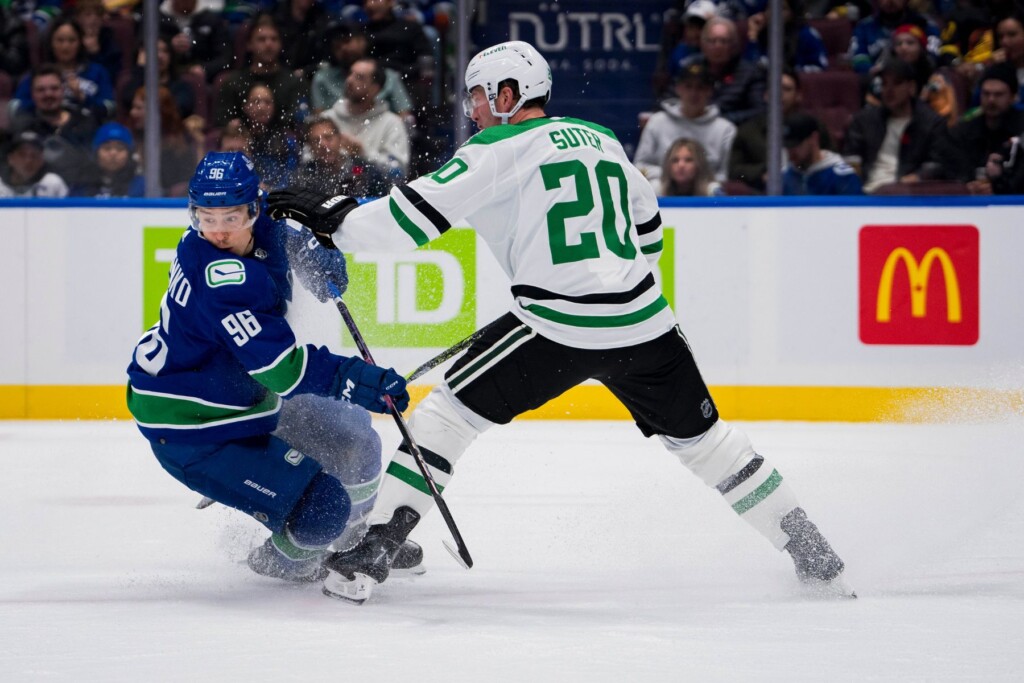The Stars began last season 7-3-1. They lost to Toronto and Boston and grabbed points when facing weaker Eastern Conference teams and Central Division rivals.
The Stars have begun this season 7-3-1. They have lost to Toronto and Boston and grabbed points when facing weaker Eastern Conference teams and Central Division rivals.
So the Stars have started just as successfully as they did last season in the only truly important category: points. But they also got knocked out of the playoffs by Vegas last spring in somewhat humiliating fashion, and that meant some changes were in order beyond telling Jamie Benn to please not do that ever again.
As is fitting, those offseason changes have been reflected in the Stars’ weakest area: their defensive corps. Ryan Suter was taken off the power play, Esa Lindell and Jani Hakanpää were split up at 5-on-5, and Miro Heiskanen was going to be kept fresher for the tougher games down the stretch and in the playoffs.
These changes each deserve a look, but it’s worth mentioning that the Stars began the season playing barely two games a week, which meant that even the first noteworthy shakeup of the forward lines didn’t happen for a while or last too long when it did come, with Mason Marchment bouncing back up alongside Tyler Seguin after a brief trip to the fourth line. Peter DeBoer has made it clear that he’s not interested in overreacting to early struggles, and the Stars’ record seems to validate that approach.
Still, coaches are humans, and we as a species tend to look for comfort food and familiar surroundings when life gets hard. With the Stars now having lost two games in a row in regulation, it’s fair to wonder how much patience DeBoer will have with the changes he has made. After all, the defense pairings looked fairly set for the first half of last year, only for Nils Lundkvist to disappear into the background as Joel Hanley and Thomas Harley assumed prominent roles in crunch time. Everything is stable until it isn’t.
And when it comes to the Stars’ top defenseman, it’s clear that DeBoer can’t resist going back to the same deep well that Rick Bowness and Jim Montgomery loved. Heiskanen was sixth in the league in ice time last year with 25:29 minutes per game, and now he’s fifth, with 25:21.
“Wait,” you might say, “isn’t that an eight-second reduction?” To which I would respond, Yes, Mr. Math Nerd, that is technically correct (which is the worst kind of correct). Except for one thing: in the first 11 games last season, Heiskanen averaged only 23:52 and topped 25 minutes in only three games. This year, he has already hit that number seven times..
Ice time for elite players tends to increase as the season wears on, so the fact that Heiskanen is already at his average from last year suggests that DeBoer is going to find it challenging to keep him fresh for the playoffs again. The temptation to mash the “MIRO” button on the console is tough to resist in the best of times, let alone when the playoff race is coming into clearer focus in March.
Then again, Harley quickly gained DeBoer’s trust last year in crunch time, so he’s as good a candidate as any to help defray the impact of those hard minutes on Heiskanen. The Stars need to find a way to do so if they want their best player to be playing at his best when the games get more important, and perhaps DeBoer will only lean on Heiskanen to this extent until he solidifies the other pairings.
Suter is another candidate for sharing the load, indirectly. His removal from the second power-play unit was done partly to make room for Lundkvist, but it may also be helping Suter to stay fresher for his other minutes. Suter has been a part of a fantastic penalty kill, and the Stars are outscoring opponents at nearly a 3-to-2 rate with Suter on the ice.
Of course, disentangling Suter’s contributions from his partner is tough when that partner is Miro Heiskanen. (This is known in some circles as The Roman Polák Quandary.) But as long as Suter looks good and the Stars see results during his minutes, you can’t ask for much more from one of the older players in the NHL, a guy who turns 39 in January. If Suter is contributing meaningfully without being taxed by power-play duties, that would be a net gain for everyone involved.
That is, of course, predicated on the power play being good. And right now, the Stars are among the worst teams in the league in both power plays drawn and power-play goals scored, squeaking out a 3-for-31 start on the man-advantage. That looks even worse when compared to their blistering start last year, when they scored 12 power-play goals in their first 12 games.
The responsibility for converting on the power play should, by rights, be largely borne by the top unit, as those players tend to get the offensive-zone faceoffs and more powerplay time in general. But if the Stars continue to struggle to convert, don’t be surprised if DeBoer reconsiders the personnel on both units. At this juncture, Harley is probably more likely to step into that second power-play unit than Suter at this point, which is far from a bad backup plan.
And hey, speaking obliquely of Lundkvist, he was stapled to Esa Lindell to start the season, which meant the dissolution of one of DeBoer’s other, er, staples from last year: the Lindell-Hakanpää duo.
On the penalty kill, that duo has remained effective. They can showcase their skills, and their deficiencies in transition are masked. But at 5-on-5, it was clear that this less-agile pairing was targeted quite effectively in the playoffs last year, with Lindell putting up a ghastly minus-12 during his even-strength ice time in the playoffs. That’s a vulnerability that Vegas and other contenders will exploit.
Determined to address that vulnerability this year, DeBoer paired Harley with Hakanpää and Lundkvist with Lindell. And although it’s early, it’s worth noting that Harley and Lundkvist got thrown together against Vancouver and Boston when the Stars were trailing and searching for goals. This necessitated a brief reunion of Lindell & Hakanpää Inc., which at least proves that, much like a Rick Bowness checking line, some things never truly disappear.
Some experimentation will always happen over the course of a long, exhausting season, and there’s nothing wrong with trying out things that don’t work. But the Stars don’t really have a choice when it comes to their defensive changes, given the issues they encountered last year. Heiskanen needs to have his legs when the playoffs approach, and the Stars need a power play that can score with either unit on the ice. And if you’re looking to win a Stanley Cup, you can’t have a defensive pairing that gets roasted by a moderately effective forecheck on a regular basis.
The philosophical shifts this year are all well-designed, but in the end, the head coach is accountable. The Stars, like most hockey teams, have a history of coaches who prefer players like Greg Pateryn, Cody Eakin, Blake Comeau, and Devin Shore, even when the results suggest they would be wise to try something different. DeBoer, at least so far, has demonstrated a willingness to experiment with his lineup that goes beyond that.
We’ll see whether DeBoer can stick to his guns as the regular season plays out. The season might be young, but it’s not too early to watch how the Stars address familiar challenges while dealing with new ones.
Author







